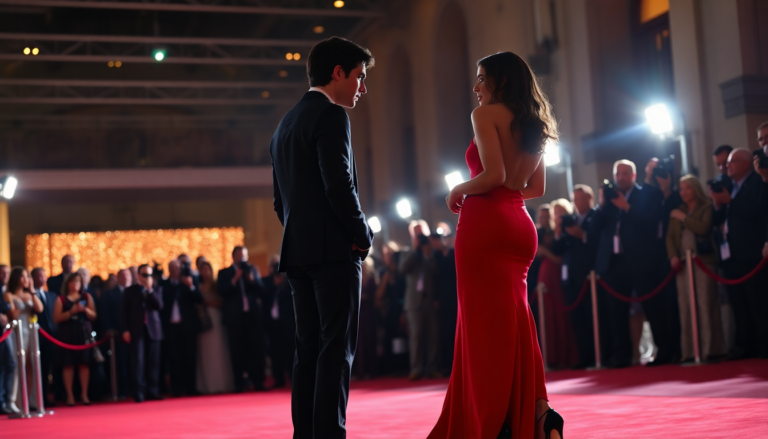Argomenti trattati
It’s fascinating how a simple red carpet appearance can ignite a firestorm of speculation. When Timothée Chalamet strolled into the David Di Donatello Awards with Kylie Jenner, the media buzzed with excitement. Here were two of today’s hottest stars, caught in a moment that many fans had been eagerly awaiting. Yet, beneath the surface of this glamorous event, a deeper narrative was brewing—one that entwined love, celebrity culture, and the unending scrutiny of public perception.
Understanding the public reaction
As the cameras flashed, and fans clamored for a glimpse, Chalamet and Jenner’s relationship was thrust into the spotlight. It wasn’t just their presence together that caught attention; it was how the media responded. Tabloids quickly mobilized their “body language experts” to dissect every glance and gesture, analyzing the emotional dynamics between the couple. Some headlines painted Jenner as the embarrassed partner, reaching for a kiss that never came. The typical narrative emerged: a powerful woman in a relationship with a younger man, and the ensuing drama that comes with it.
But isn’t it exhausting? This cycle of speculation isn’t new. We’ve seen it before with couples like Prince Harry and Meghan Markle or Tom Hiddleston and Zawe Ashton, where every movement is scrutinized, and every relationship is questioned. It’s almost as if the media thrives on creating a narrative that fits its expectations rather than acknowledging the reality of the situation. I remember when I first noticed this pattern—watching the press tear apart celebrity relationships and wondering why we, as a society, feel the need to dissect love like it’s some sort of mathematical equation.
The conspiracy theories at play
With any high-profile couple, the whispers of conspiracy inevitably arise. Chalamet and Jenner are no exception. Social media exploded with theories labeling their romance as a mere PR stunt. Comments ranged from mildly amusing to downright absurd, with some suggesting that Chalamet was a hostage in this relationship. It’s a surreal phenomenon: the idea that two people who seem to genuinely enjoy each other’s company are somehow orchestrating an elaborate charade for fame.
But let’s take a step back. The idea that celebrities might engage in PR relationships is not entirely unfounded. History is replete with examples—from Rock Hudson and Natalie Wood’s carefully crafted public personas to the modern-day stars who navigate their careers with strategic partnerships. However, this doesn’t mean that all relationships in the limelight are manufactured. The truth is often far less exciting than the stories we create to explain them.
Why do we cling to these narratives?
Why do we indulge in these conspiracy theories about celebrity relationships? It’s a question worth pondering. As humans, we crave narrative. We like to understand the world around us through stories, even if it means bending the truth. Conspiracies often offer a sense of control—an illusion that we can comprehend the complexities of human relationships in a way that feels satisfying. It’s easier to believe that there’s a grand scheme at play than to accept the mundane reality that two people might just be enjoying each other’s company.
Interestingly, Naomi Klein’s book *Doppelganger* delves into this concept, suggesting that our tendency to create elaborate narratives reflects our discomfort with the truth. In a world where genuine relationships are often overshadowed by media manipulation and public personas, it’s no wonder that fans find solace in the idea of a conspiracy. It’s a defense mechanism to shield ourselves from the uncomfortable reality that fame can distort love.
The complexities of fame and love
As we dissect the relationship between Chalamet and Jenner, it’s crucial to acknowledge the complexities that come with fame. Many fans struggle to reconcile the idea that their idols—often viewed as paragons of virtue—might engage in relationships that are calculated or strategic. The notion of a celebrity calling the paparazzi on themselves or staging moments for media attention feels disingenuous. However, this transactional nature of fame is often just a part of the landscape.
Personally, I remember the first time I saw a couple of celebs playfully embracing the paparazzi culture. It was both fascinating and unsettling. Here were two people seemingly in love, yet their every move was choreographed for public consumption. It blurs the line between authenticity and performance. Are they genuinely in love, or is it simply a means to boost their public image? This question lingers in the minds of many fans.
Looking ahead
As we navigate the murky waters of celebrity relationships, I find myself hoping for a shift in our collective mindset. Instead of being quick to judge or dismiss a relationship as a PR stunt, perhaps we can approach it with a spirit of curiosity. After all, love can be both complex and beautiful, even in the realms of fame and fortune. As we continue to watch the unfolding stories of couples like Chalamet and Jenner, let’s strive to embrace the uncertainty rather than succumb to the comforting allure of conspiracy.
In a world where sensationalism often trumps reality, it’s vital that we recognize the human experience behind the headlines. So, the next time you find yourself caught up in the whirlwind of gossip and speculation, pause for a moment. Ask yourself: what’s the real story here? And maybe—just maybe—we’ll find that the truth is far more interesting than the conspiracy.

